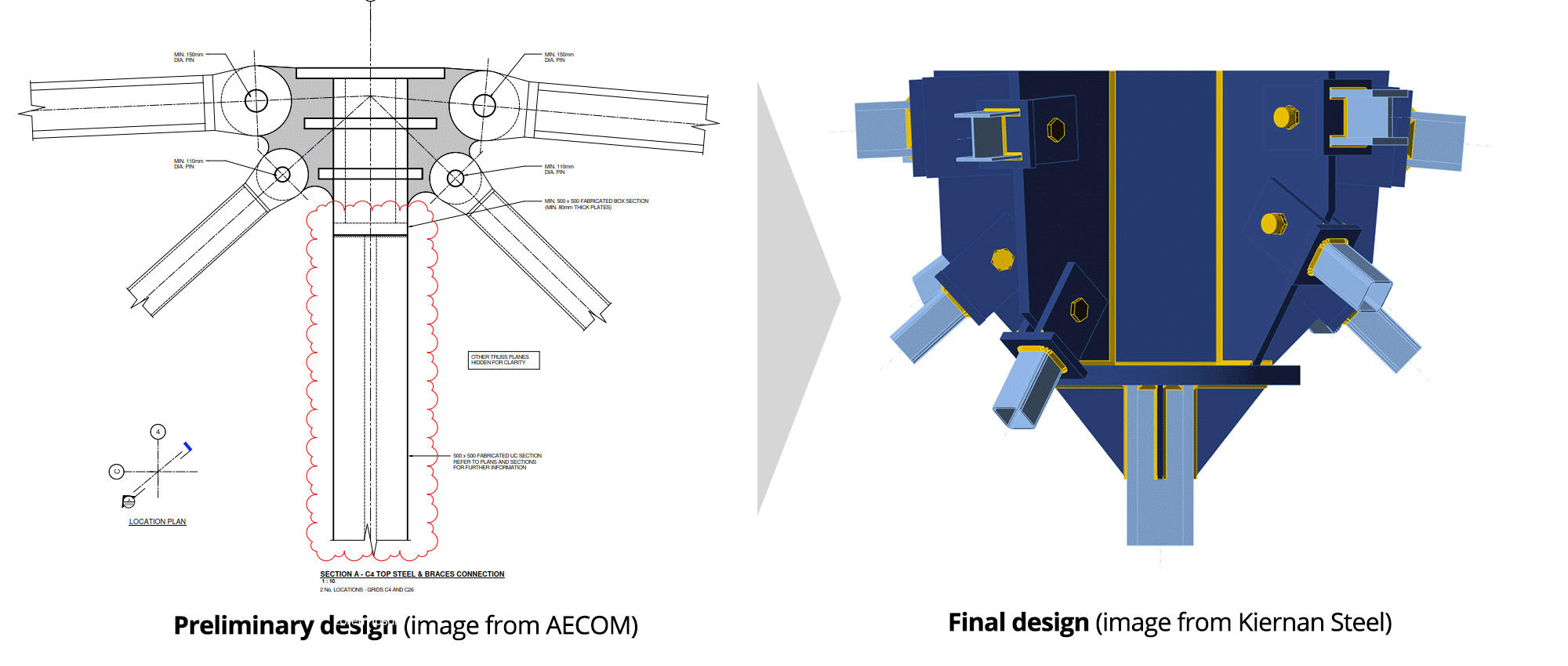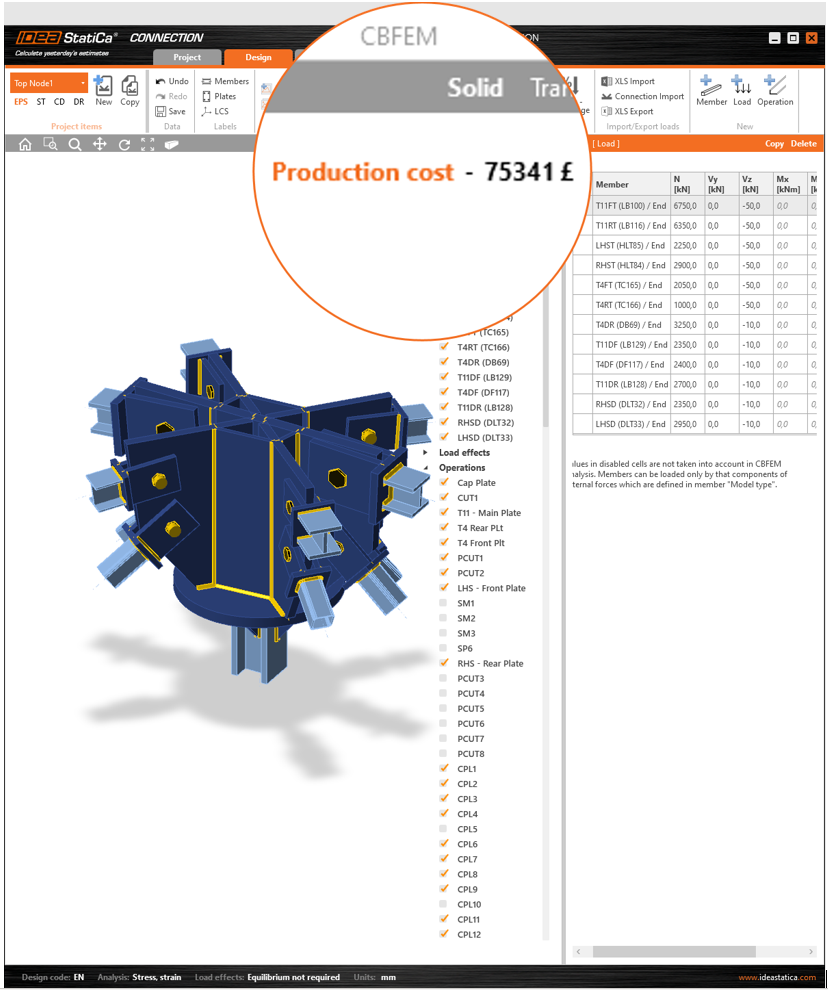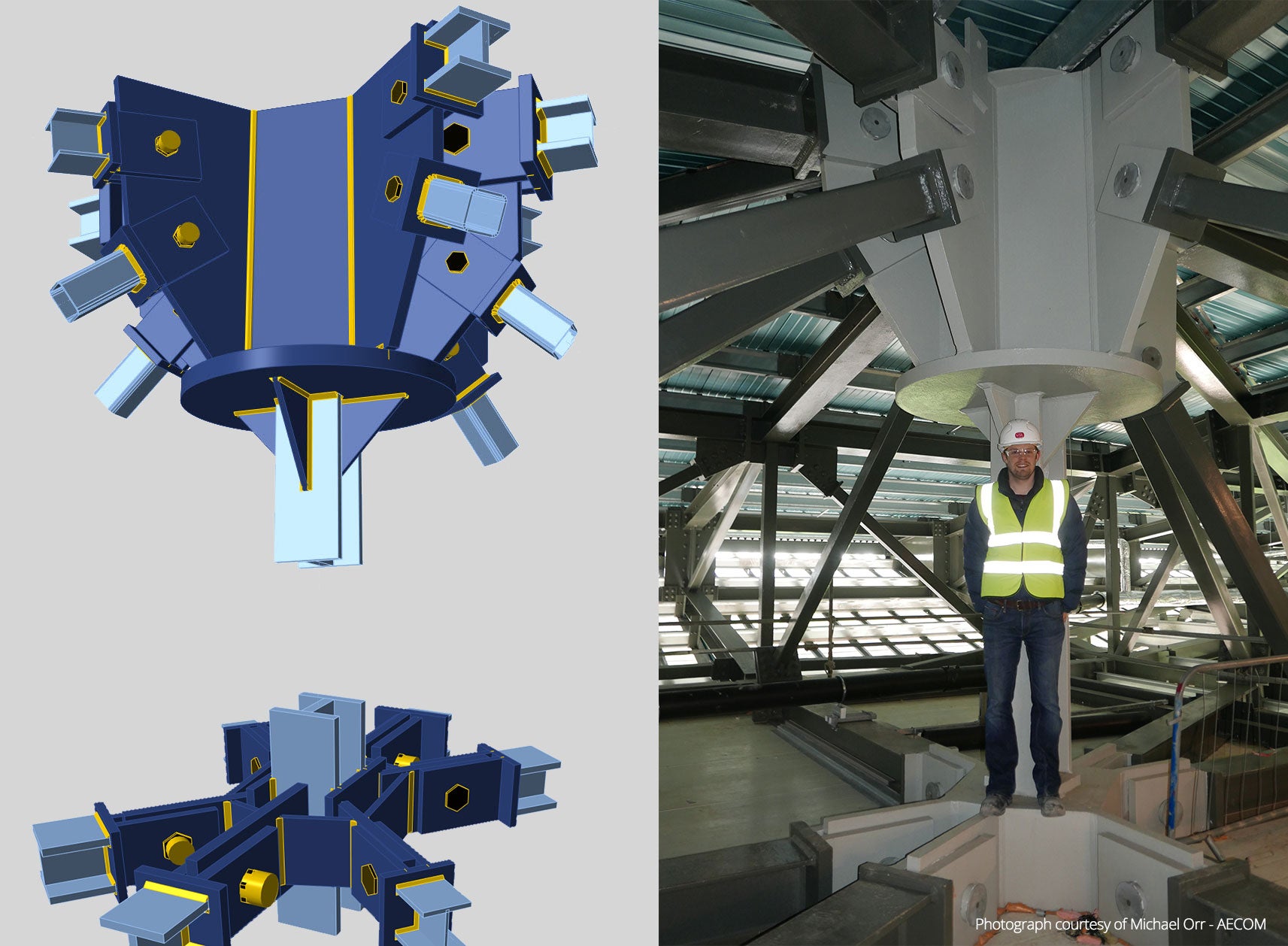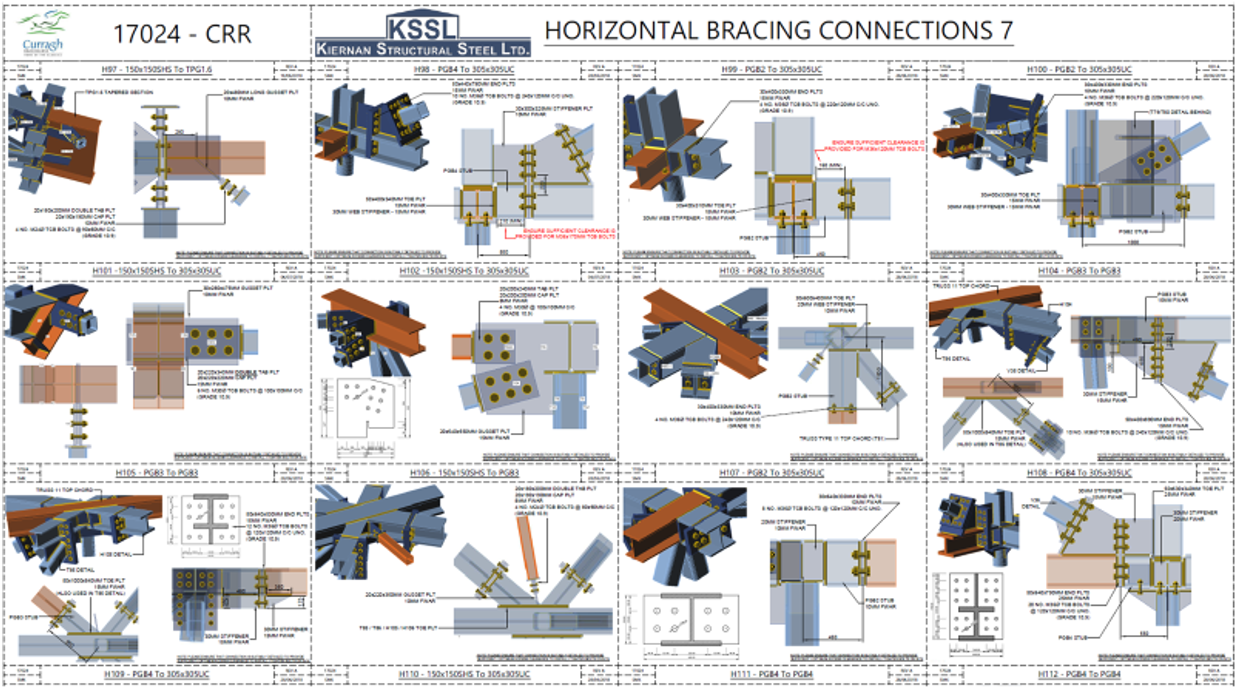Plugging IDEA StatiCa into the fabrication process
Through our support services we had the opportunity to interact with them at every stage, get a closer look at many iconic projects, and learn a lot regarding the fabrication process and how IDEA StatiCa was implemented into their connection design process.
In this article, we would like to share some of this experience and summarize how IDEA StatiCa can fit into the fabrication process, streamline the communication between the different stakeholders, and optimize the designs in terms of cost and constructability.
Preliminary design vs Design for fabrication
It is quite common during the engineering process to change preliminary designs for fabrication. Sometimes, even theoretically sound designs must be completely revised to account for factors that were not considered by the structural engineer. To make this easier to digest, let’s provide an example.
In the following pictures, we see a very complex node with 13 incoming members, with the initially proposed design on the left, and the final design by the fabricator on the right.
The above connection is part of the Curragh Racecourse in Ireland, designed by Kiernan Steel
The difference between the two connections is quite significant and there is a very simple reason for this. Constructability requirements form a particularly complex equation involving factors like available equipment, worker access, erection phases and the delivery schedule. All these factors interact and influence the design decisions in a way that is unique to each project and fabrication process.
To put this in context, for the aforementioned connection, the size of the pins which weigh up to 100 kg creates an issue during the erection process as additional space requirements emerge for equipment and access. For structural engineers, this is just a value from a table, but from a constructability point of view, this influences the design decision.
Therefore, all connected members have been moved away from the node. This is a simple thing in theory, but when you have 12 such incoming members and you need to ensure that no clashes take place, the IDEA StatiCa 3D modeler becomes an indispensable tool.
Moreover, one can assess the weight of each connection element during the creation of a BOM report at any stage of the connection design. This provides additional insight into things that matter for the fabrication process. Did you ever realize for example, that an M52 bolt could weight about 30kg depending on its length?
Excerpt from report
Another alarming consideration in the preliminary design of the connection mentioned was the extensive use of butt welds. For us, structural engineers, butt welds are quite convenient as they may not require any calculation at all and simultaneously guarantee the full-strength capacity of the welded elements. Which means that we pass the design burden to the fabricator.
A butt weld means that, for each plate, a preparation ranging from half to one day is required (for the specific joint) and then a test must be performed to assess the full-strength capacity promise. If the test fails, the procedure needs to be repeated from start.
Now imagine, that you as a fabricator, need to design, fabricate, and erect 1100 tons in a congested 6-month window. Eliminating every potential delay factor is mandatory, or in other words, replacing as many butt welds as possible with fillet ones.
All these factors created the need for a substantially bigger design that allows the positioning of pins during the erection process and welder access from the outside as fillet welds were finally utilized.
Avoid overdesigns
Connection overdesign is quite common for complex connections. This practice ensures that the required safety margins are respected when the application of code provisions is ambiguous. However, this has an impact on the fabrication cost and raw material weight.
Our advanced analysis tools can reduce these costs with the removal of calculation ambiguities. Our tools adopted the state-of-the-art CBFEM methodology that allows an accurate assessment of any connection topology and removes the uncertainties of the established component method.
Additionally, our BIM links allow the assessment of connections under multiple combinations in contrast to the established practice of simultaneously loading with maximum internal force components that, in reality, do not act together. This results in designs that are both safer and potentially economical.
Finally, our tools can seamlessly plug into the existing fabricator workflows. The automation of the model and/or load transfer through BIM links or xlsx files directly from the structural models does not only increase accuracy but also reduces the probability of human error.
Control your costs early in the design
The latest version of IDEA StatiCa features the real-time calculation of the production cost in the design window. This cost depends on a template of parameters that is fine-tuned to match the requirements of a specific project or a specific fabricator process.
Then according to these rules, the production cost is calculated and displayed live in the graphical window. This cost is updated with every modification of the model.
Real-time cost calculation
To prove the value of this feature, we did a poll among 100+ webinar participants, and we asked them to make a guess about the production cost of the connection that is displayed in the previous screenshot (that uses the default average market prices for materials and labor). Surprisingly, only 4% of the participants could approximate the actual connection cost, while 72% underestimated it by a lot.
Production costs - webinar poll
This leads us to two things:
- Although engineers are familiar with material weights and the fabrication process, the actual cost calculation is very difficult to predict. Costs are usually calculated from the commercial departments, which could prove to be too late in the design decision process since projects are under strict deadlines.
- Even an accurate 3D model cannot provide a sense of the magnitude of some connections. Although we can see something in a realistic representation, it is very difficult to put it into perspective and have a sense of the cost.
Putting the connection into perspective
Either way, this small experiment proves that constraining the cost at the early stages of design is tricky and special tools are required. IDEA StatiCa production cost calculation is an indispensable tool for fabricators as it is enforcing one of the most important dimensions of fabrication: raw material cost & labor cost. Using this feature during the fabrication process can help businesses enforce cost constraints early in the design process even with inexperienced designers.
Conveying the design intent
Another aspect of the fabrication process is to communicate results back and forth with the structural engineers. This process is both time-consuming and error-prone.
One of the most creative uses of IDEA StatiCa that we have come across is the utilization of screenshots from the 3D model to communicate the design. Taking into account that unusual connection topologies can be modeled in the software, this clever usage of IDEA StatiCa accelerates the drawing creation and, as a result, the overall decision-making process.
Drawing produced from IDEA StatiCa screenshots
Currently, IDEA StatiCa offers modern tools that can reduce the time required for communication and ensure that every aspect of the intended design is conveyed. One such tool is the online Viewer, where our clients can share their models with other parties. Through their favorite browser, with a single drag-and-drop, the other party (owner, consultant, checker or similar) can inspect every part of the designed connection in a 3D environment. Every single part of the model can be rotated and interrogated. It is even possible to produce 3D DWG files which can then be downloaded locally and used for further processing.
A complex 3D model in our online Viewer displaying the properties of an isolated plate
Summing up
The fabrication process is a different important phase, with distinct requirements from the rest of the design phases. Fabricators can benefit from the IDEA StatiCa connection design toolkit in the following ways:
- Design connections while ensuring constructability from the early stages of design
- Control the overall production cost during the design process
- Adapt to changes with confidence in a timely manner
- Streamline the communication between project stakeholders
- Provide a better understanding of the connection behavior
Author:
Costis Hatzopoulos
Technical Manager at IDEA StatiCa UK








